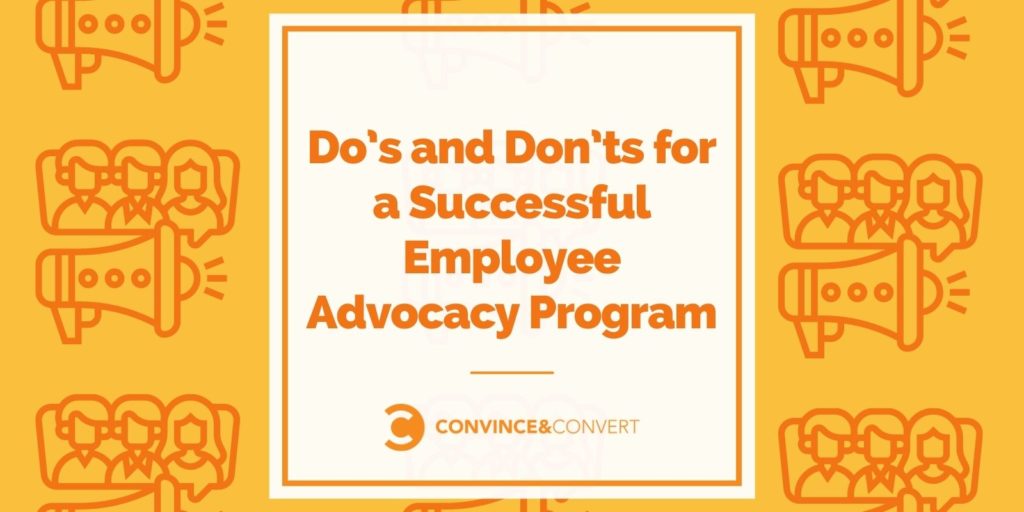According to the 2021 Edelman Trust Barometer, trust in organizations and every category has plummeted across the board, especially in comparison to other years. But one of the few areas that remains one of the most trusted sources of information? People.
That means when it comes to building trust and gaining your audiences’ attention, your employees are your greatest asset, and it’s even better when they can advocate on your behalf.
But you can’t just put an employee advocacy program in place and hope for the best. Instead, follow a few do’s and don’ts to help make efforts more successful.
DO start with your goals for employee advocacy
Why exactly are you trying to kickstart your organization’s employee advocacy efforts?
Before you go all in on getting employee advocacy off the ground and getting everyone involved, make sure you understand exactly how employee advocacy fits into your current content marketing and social media efforts.
For example, are you hoping employee advocacy will:
- Provide a surround sound effect by amplifying key brand messages and efforts?
- Reinforce your brand’s commitment to authenticity by using real, genuine voices?
- Reach even more people with messages shared by more messengers?
Whatever your goals are, make sure you solidify them before you jump in. It also doesn’t hurt to make them S.M.A.R.T:
- S: Specific – What exactly will be accomplished?
- M: Measurable – What are you measuring, and how?
- A: Actionable – Is the goal realistic? Can you actually accomplish it?
- R: Relevant – How does this goal ladder up to the big picture for your organization?
- T: Time-bound – When do your goals need to be accomplished?
DON’T assume everyone is on the same page
It’s one thing to create an employee advocacy program, but it’s another to participate in one.
While you may understand exactly what employee advocacy efforts look like based on your S.M.A.R.T. goals, you can’t assume the same for everyone else.
But you can help them better understand by creating and documenting clear guidelines that help explain:
- What employee advocacy is and looks like for your company
- What you want to accomplish with their participation (i.e., your S.M.A.R.T. goals)
- What’s in it for them for participating (e.g., become a thought-leader, raise visibility for things they’re excited about working on, promote skills and talents, etc.)
- How all of this will come to life and get done
While this document can’t and won’t answer every question they have, it should give them a very good idea of what employee advocacy efforts look like for your organization.
And when it comes to putting the document together, keep it simple. It should be skimmable, scannable and easy for them to digest.
DO provide multiple ways for employees to be advocates
How fantastic would it be if every single employee had the extra time and drive to create beautifully written thought-leadership articles, develop attention-grabbing LinkedIn updates, or share and comment on every single social media post your organization publishes?
Yeah, it’s not going to happen.
That’s why you need to have several, different options available to get the most participation with employee advocacy efforts.
Maybe an employee can only create one thought-leadership article per quarter. Great!
Maybe someone only has enough bandwidth to react to a Facebook post. Awesome!
Maybe a team member is more comfortable consistently sharing branded posts. Fantastic!
Not every employee has to be 100% all in and on board with being your brand’s megafan to participate in employee advocacy efforts. That’s not the point of employee advocacy efforts.
The point is for employees to advocate in genuine and authentic ways, and those ways look different for everyone. So, provide multiple different options for getting involved (if they’re interested in participating, of course).
DON’T expect employees to add advocacy efforts on top of their to-do list
Let’s face it: the pandemic has left pretty much the entire workforce over-stressed and rethinking their entire work life and career. As NPR found:
“As pandemic life recedes in the U.S., people are leaving their jobs in search of more money, more flexibility and more happiness. Many are rethinking what work means to them, how they are valued, and how they spend their time.”
Bottom line: You cannot have an employee advocacy program if your employees don’t feel valued. And asking them to advocate on behalf of your company by adding to their already-overwhelming to-do lists and never-ending tasks will absolutely not help.
Instead, depending on their level of involvement, let them know they’re able to participate in employee advocacy efforts by giving them the time and resources to do so…not just another to-do so they feel even more overwhelmed.
DO communicate regularly and consistently
Employee advocacy efforts are not a Ronco Showtime Rotisserie. You can’t just “Set it and forget it!”, even if that is the best tagline ever created.
You have to communicate regularly for efforts to work, especially after the initial excitement and rush of employee advocacy participation starts to wane.
To keep everyone motivated and encourage ongoing efforts:
- Provide regular status updates: Include updates on efforts, what the team has accomplished, and how much their participation has helped toward the goals set. Also, be sure to ask for feedback and open the floor to new ideas, too.
- Use advocacy tools to push content to employees: Adopt tools that can help you push messages, requests and content to advocates, such as Bambu. But no matter which tool you use, make sure it’s user-friendly and can be easily adopted by anyone.
- Be clear and direct with advocacy asks: Need a specific event amplified on social media? Want more people to share the latest blog post? Need someone to write a thought-leadership article? Ask them directly, be specific with what you need them to do, and make sure they have all the information they need to participate.
Employee advocacy efforts are not a Ronco Showtime Rotisserie. You can’t just “Set it and forget it!”.
Click To Tweet
Do It Together!
In the end, employee advocacy is a powerful tool that can help you harness the power of your team’s genuine, authentic and real voices. Putting a few safeguards in place, and following a few simple do’s and don’ts, you can take your efforts from just so-so to so successful.
The post Do’s and Don’ts for a Successful Employee Advocacy Program appeared first on Content Marketing Consulting and Social Media Strategy.



